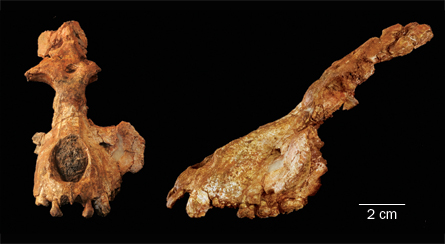Fossil find resets timing of major event in primate evolution
 Evolutionary findNewly discovered pieces of an ancient primate skull, including a face and frontal braincase shown here from the front and side, suggest to scientists that
Evolutionary findNewly discovered pieces of an ancient primate skull, including a face and frontal braincase shown here from the front and side, suggest to scientists that
A slope-faced, big-toothed creature from the distant past has inspired scientists to recalibrate the ancient evolutionary split between apes and
Evolutionary findNewly discovered pieces of an ancient primate skull, including a face and frontal braincase shown here from the front and side, suggest to scientists that
A slope-faced, big-toothed creature from the distant past has inspired scientists to recalibrate the ancient evolutionary split between apes and
Discoverers of a partial apelike skull in western  ence, between 34.5 and 29.2 million years ago.
ence, between 34.5 and 29.2 million years ago.
An intriguing mosaic of features on the newly unearthed fossil, which dates to between 29 million and 28 million years ago, suggests that it lived shortly before a common ancestor that gave rise to hominoids — a primate lineage that includes apes and humans — and the monkeys of Africa, Asia and Europe. A team led by anthropology graduate student Iyad Zalmout of the University of Michigan in Ann Arbor reports the find in the July 15 Nature.
Zalmout and his colleagues assign the skull to a new primate genus and species, Saadanius hijazensis.
“This is wonderful discovery, a real missing link that fills in a gap in our understanding of the timing and pattern of anatomical change involved in the evolution of Old World monkeys and apes,” remarks anthropologist John Fleagle of Stony Brook University in New York.
Zalmout, working with members of the Saudi Geological Survey in Jeddah, found the partial Saadanius skull on February 17, 2009, in a section of
Saadanius sports a projecting snout, a relatively tall face with long, narrow nasal bones, broad cheek teeth and other traits resembling those of older primates previously unearthed at a geological formation on the edge of
But a few critical anatomical features, including a long, tube-shaped ear canal, distinguish Saadanius from its primate predecessors, the scientists say. And unlike
For that reason, the researchers use 24 million years as the most recent estimate of when
Anthropologist Brenda Benefit of
Saadanius apparently lived not long before
That makes it difficult to narrow down the timing of an ape–Old World monkey divergence, says anthropologist Elwyn Simons of
Although additional fossil finds are needed, the Saudi specimen offers a more reliable age estimate for a crucial shift in primate evolution than can be gleaned from DNA studies of living apes and monkeys, comments anthropologist David Begun of the University of Toronto.

 Previous page
Previous page Back to top
Back to top







